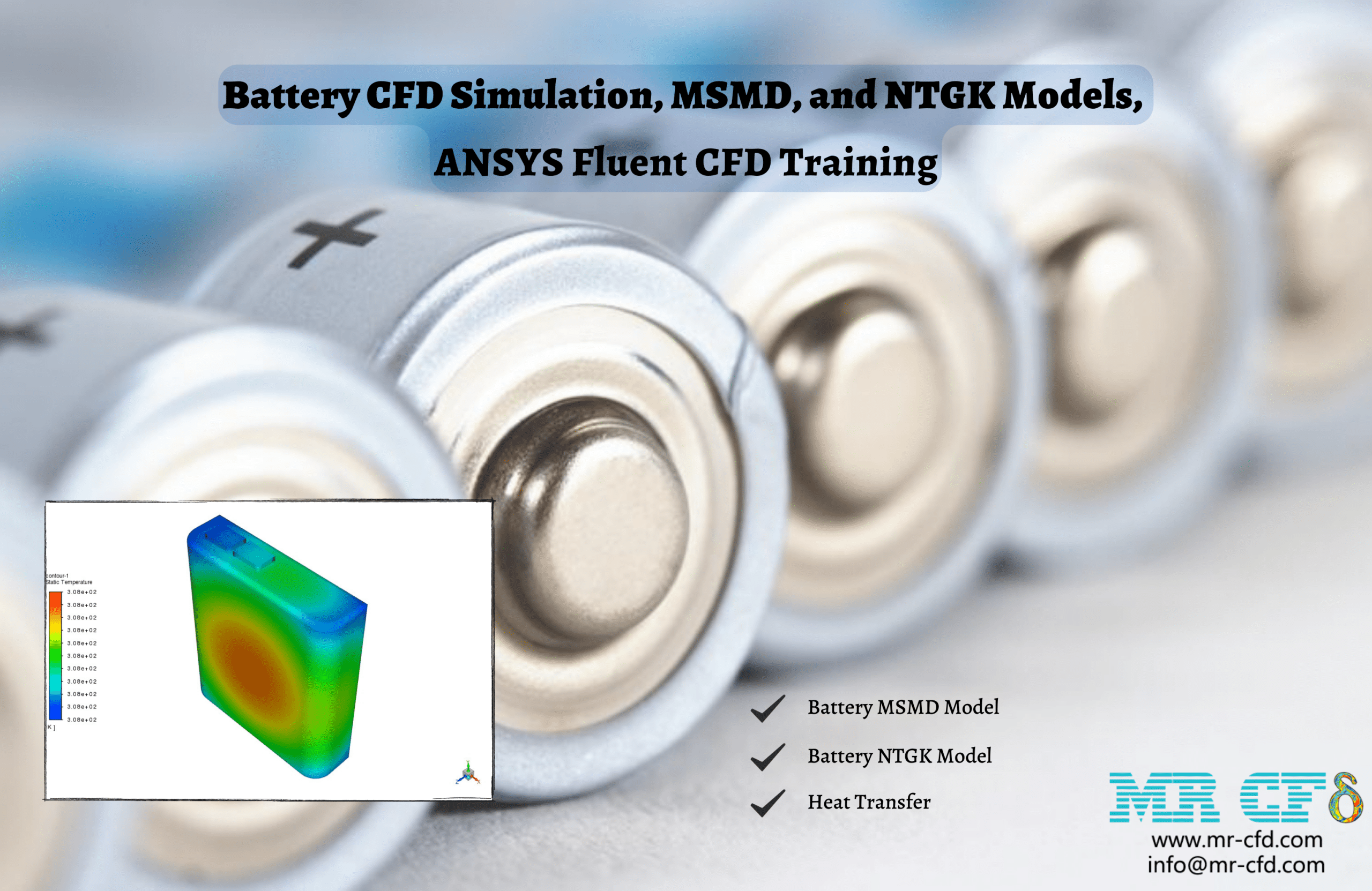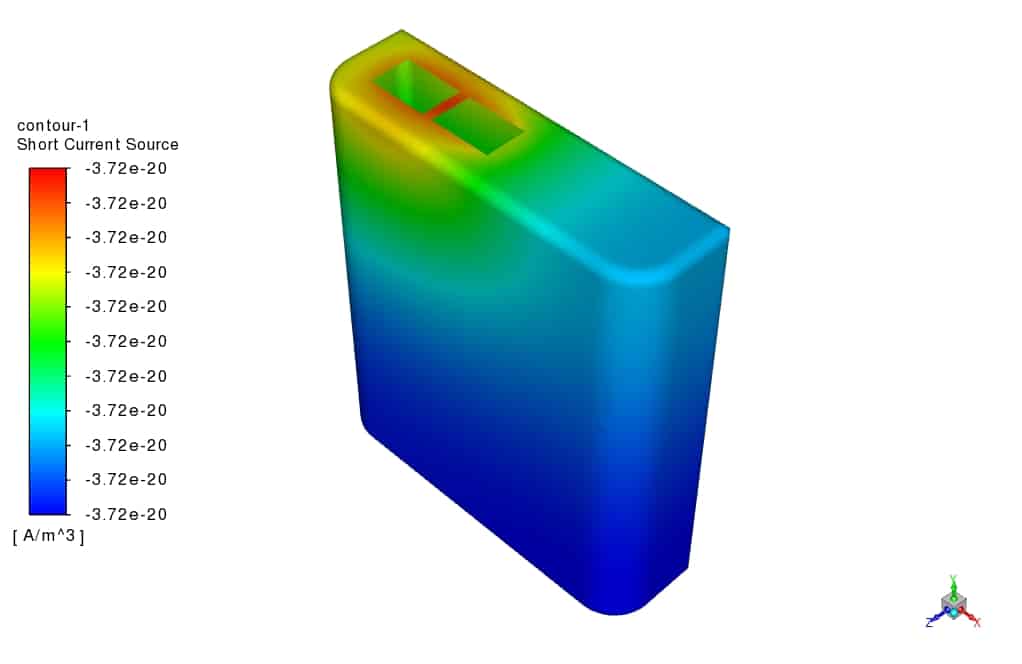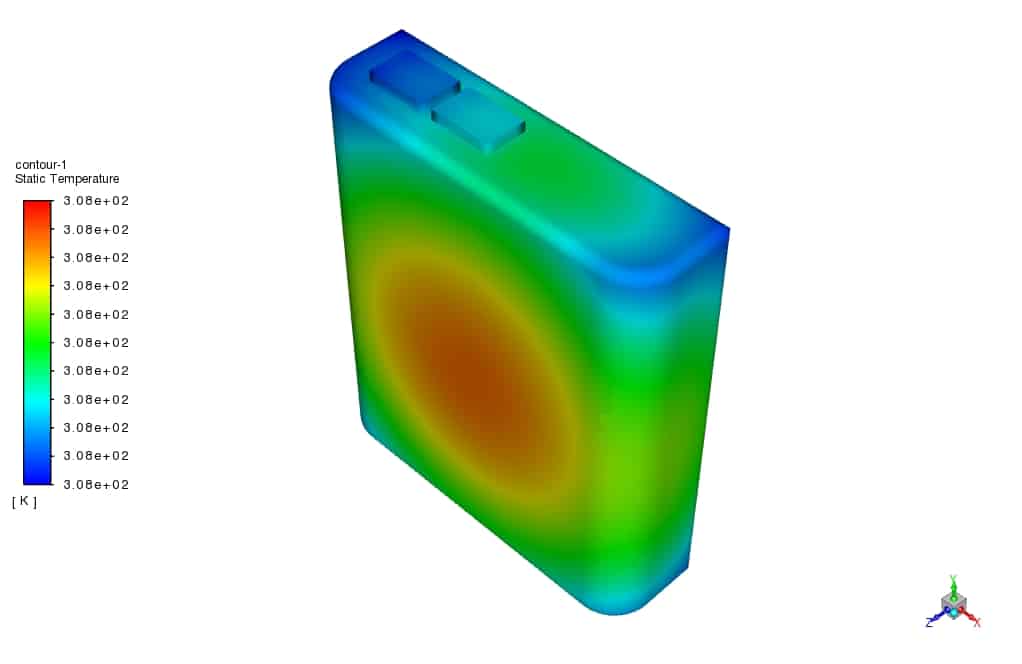Battery CFD Simulation, MSMD and NTGK Models, ANSYS Fluent CFD Training
$180.00 $90.00 Student Discount
- The current CFD project simulates the temperature distribution of a Battery via ANSYS Fluent software.
- We have designed the geometry using ANSYS Design modeler software and created the mesh on this geometry using ANSYS meshing software.
- The mesh type is Unstructured with 200,848 cells.
- MSMD (Multi-Scale Multi physics Battery) and NTGK (Newman, Tiedemann, Gu, and Kim) Models are used to analyze the current Unsteady problem.
To Order Your Project or benefit from a CFD consultation, contact our experts via email (info@mr-cfd.com), online support tab, or WhatsApp at +44 7443 197273.
There are some Free Products to check our service quality.
If you want the training video in another language instead of English, ask it via info@mr-cfd.com after you buy the product.
Description
Description
The simulation is done on a battery that is based on Sony’s NP-FG1 lithium-ion commercial battery, which is widely used in all kinds of cameras.
The simulation is performed using the MSMD model and the NTGK method with ANSYS Fluent software. Its characteristics, including state of charge and temperature distribution on the body and voltage distribution, etc., have been checked to get a correct view of the performance of this battery.
The present model is designed in three dimensions using Design Modeler software. The geometry used is produced based on the dimensions of the NP-FG1 battery and includes three parts the negative and positive tab and the battery cell. Positive and negative batteries are considered passive, and battery cells as active cells in the simulation.
We carry out the model’s meshing using ANSYS Meshing software, and the mesh type is unstructured. The element number is 200,848.
Methodology: Battery CFD Simulation with MSMD and NTGK Models
Given the important role of a battery in electric and/or hybrid electric vehicles, several models have been proposed to simulate the Transient behavior of the rechargeable battery. These models vary in complexity from a zero-dimension resistor-capacitor to a multi-dimension potential current distribution. The general model available in the software is known as MSMD (Multi-Scale Multi physics Battery) Model.
The NTGK model is set up by a curve fitting the experimental data. And this model is used to obtain the total heat from an electrochemical reaction and predict the temperature distribution of the battery cell.
Conclusion
The simulation results, as seen above, show that the temperature reaches equilibrium at 308 degrees and the middle of the battery body is warmer than other parts of the battery. The battery charging time is about 25 minutes and supplies 3.6 volts.












Shany Huels –
The training for the Battery CFD Simulation using MSMD and NTGK Models in ANSYS Fluent is impeccable! The detailed explanations and thorough exploration of temperature distribution and voltage characteristics have greatly enhanced my understanding of battery performance in practical scenarios.
MR CFD Support –
Thank you for your positive review! We’re thrilled to hear that our training on Battery CFD Simulation using MSMD and NTGK Models in ANSYS Fluent was helpful and informative. It’s great that the detailed approach has added to your understanding of battery performance. We appreciate your kind words and look forward to providing more valuable learning experiences.
Deion Koss DDS –
Following the training, I’m curious if there’s any point within the battery cell that tends to overheat compared to the rest, and if yes, how is this monitored?
MR CFD Support –
In the simulation, typically, areas with a high electrical or chemical reaction rate may show a tendency to overheat. Using the NTGK model, this simulation monitors temperature distributions, allowing the identification of hot spots within the battery cell. SIMULATION data informs us that the middle of the battery body is warmer and predictive measures like implementing cooling strategies or redesigned cell geometry would be used to mitigate any risk of overheating.
Mrs. Sophia Strosin –
I’m very impressed with the detail of this battery CFD simulation’s analysis! It seems like MR CFD Company’s training is extensive.
MR CFD Support –
Thank you for your kind words! We’re glad you find the details of the battery CFD simulation valuable. At MR CFD, we strive to provide a comprehensive understanding of simulation mechanics and real-world applications. If you have any further questions or need more insight, feel free to reach out!
Cathrine Watsica –
I was thrilled by the detailed analysis performed for the battery CFD simulation. It’s quite fascinating how temperature distribution and state of charge impact the overall performance. Well done!
MR CFD Support –
Thank you so much for your kind words! We’re glad that you found our analysis fascinating and insightful in understanding the performance of battery simulations. Your enthusiasm for our work really means a lot to us. If you have any more questions or need further clarifications, feel free to reach out.
D’angelo Dach –
I enjoyed learning from the ‘Battery CFD Simulation’ training project by MR CFD Company. The step-by-step approach made it very easy to follow along and I now have a better understanding of different battery modeling approaches like MSMD and NTGK. Seeing the effects on the battery’s temperature and charge states was especially interesting, and I appreciate how the course breaks down complex CFD concepts into manageable parts.
MR CFD Support –
Thank you for your positive feedback on our ‘Battery CFD Simulation’ course. We’re glad to hear that our training was easy to follow and provided you with a clear understanding of battery modeling. It’s great that you found the temperature effects and charging time simulations to be insightful. Your satisfaction is very important to us, and we look forward to providing you with more quality CFD learning materials in the future.
Oscar Buckridge –
The simulation training was instructive and brilliantly outlined the behavioral dynamics of a lithium-ion battery under operational conditions. The application of MSMD and NTGK models provided precise temperature distribution and charge characteristics. Great job on detailing the process and anticipated outcomes!
MR CFD Support –
Thank you for your positive feedback! We are thrilled to hear that you found the Battery CFD Simulation training helpful and the explanations clear. Your satisfaction is our top priority, and we are glad to know that the training met your expectations. If you have any further questions or need additional information, feel free to reach out.